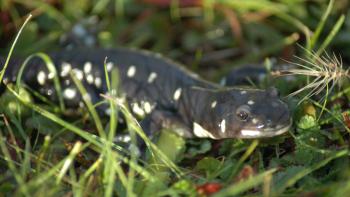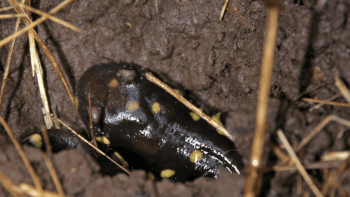Winter Wildlife: California tiger salamander

It’s salamander season, when California tiger salamanders are returning to their ponds to breed.
These critters are relatively large compared to other salamanders, like the four-inch-long slender salamander, as they average about 6 to 10 inches in length. You can identify them by their black bodies speckled with white or yellowish spots.
California tiger salamanders (CTS) play a critical role in their complex food web. As larvae, salamanders feed on small crustaceans and aquatic insects, and as they get older, they hunt larger prey like tadpoles, insects, and frogs. These stunning amphibians are also prey for snakes and predatory aquatic insects.

During the summer, CTS migrate away from their birth ponds to find burrows -- like those made by ground squirrels -- and begin aestivation (or hibernation during the summer). Interestingly, these critters don’t mind cohabitating in burrows that are still occupied by the rodents that dug them. The more the merrier! CTS prefer to occupy burrows in grassland and savanna habitats. This allows them to travel safely between breeding and non-breeding habitats.

Every winter during rain events they return to their breeding ponds and stay there until the spring, depending on levels of rainfall. Rainfall is critical to the developmental success of larvae, which metamorphosize when submerged in water. As the water evaporates, they begin the next stage of their growth. The deeper the water, the more developed the larvae become. If the water evaporates too early, the chances of survival for the larvae decreases.

This illuminates the importance not only of rainfall, but also pond habitats. California tiger salamanders are listed as a threatened species, and the leading causes of their decline are habitat loss and habitat fragmentation.
The Open Space Authority is working diligently to restore habitat for these critters, fostering the health of local ponds and pond connectivity, with its Pond Management and Enhancement Project. This project will enhance habitat of the CTS as well as the western pond turtle and the California red-legged frog by enlarging and deepening the select ponds, promoting wetland vegetation, and much more.
To learn more about the salamanders that call the Santa Clara Valley home, click HERE.



